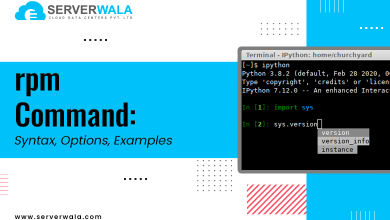How to List All Databases in PostgreSQL? – Serverwala

Introduction
Navigating through databases is a fundamental skill for PostgreSQL users, and understanding how to list databases is key to efficient database management. In this comprehensive guide, we’ll delve into various methods to list all databases in PostgreSQL, addressing diverse preferences and environments. Whether you lean towards the command line with psql, enjoy the flexibility of SQL queries, or prefer the graphical interface of pgAdmin, rest assured, we’ve got you covered with detailed insights and step-by-step instructions.
Listing Databases via Psql Terminal

For aficionados of the command line, the psql terminal is a powerful ally in PostgreSQL database management. To effortlessly list all databases, open your terminal and enter:
psql -l
This command serves as the gateway to a wealth of information, offering a comprehensive list of databases accompanied by details like owner, encoding, and access privileges. It provides an insightful snapshot of your PostgreSQL server’s database landscape.
Moreover, within the psql shell, you can wield another handy command:
\l
This concise yet potent command achieves the same result, presenting a straightforward list of databases available on your PostgreSQL server. It’s a quick and effective way to gather essential information about your databases, facilitating efficient decision-making in your database management endeavors.
Listing Databases via SQL Query

For those who lean towards the elegance of SQL queries, PostgreSQL offers a straightforward method to list databases. Execute the following SQL query within your PostgreSQL environment:
SELECT Datname FROM pg_database;
This concise yet powerful query fetches the names of all databases on your PostgreSQL server. Beyond its simplicity, the versatility of this method shines as it can be seamlessly integrated into your scripts or applications. Whether you’re automating tasks or building a database management application, this SQL query provides a robust foundation for gathering essential information about your PostgreSQL databases.
For enthusiasts of graphical user interfaces, pgAdmin stands out as the preferred tool for PostgreSQL database management. Following a seamless connection to your PostgreSQL server, navigate effortlessly to the ‘Databases’ node in the left panel.
- Connect to your PostgreSQL server in pgAdmin.
- In the left panel, expand the ‘Databases’ node.
There, you’ll be greeted with a comprehensive list of all databases hosted on your PostgreSQL server. Each entry is accompanied by detailed information, offering insights into crucial aspects such as size, owner, and the number of objects within the database.
Leveraging the power of pgAdmin’s graphical representation enhances your ability to make informed decisions about your databases. The user-friendly interface simplifies the exploration of database properties, allowing you to delve into specifics effortlessly.
Listing Users in psql
Ensuring a comprehensive understanding of user access is paramount in effective database management. Within the psql terminal, you can effortlessly list users by executing the following command:
Syntax:
\du
This command serves as a gateway to a detailed list of users, unraveling insights into their roles, privileges, and attributes. The information provided enriches your comprehension of user permissions within the PostgreSQL environment, empowering you to manage access and permissions with precision.
In the realm of user management, this psql command is invaluable for administrators aiming to maintain a clear overview of who has access to the databases. The insights gained enable proactive decision-making and contribute to the robust security and integrity of your PostgreSQL databases.
Listing Tables in PostgreSQL
Once databases are enumerated, delving into the realm of tables becomes essential. To view tables for a specific database using psql, follow these steps:
- Connect to the desired database.
- Execute the following command:
\dt
This straightforward psql command efficiently lists all tables within the connected database, providing a quick overview of the database’s structure. In the graphical interface of pgAdmin, a seamless exploration of tables awaits after selecting a specific database and navigating to the ‘Tables’ node in the left panel.
Whether you opt for the simplicity of the command line or the visual appeal of a graphical interface, these methods ensure a comprehensive understanding of your PostgreSQL databases, from user access details to the structure of individual tables. Incorporate these commands into your routine to enhance your PostgreSQL database management capabilities.
Also Read: Ping Command Examples for Linux Users
Final Words
Concluding our exploration of PostgreSQL database listing methods reveals a diverse set of tools catering to different preferences and database management needs. Mastery of listing databases in PostgreSQL is pivotal for effective administration, whether through the simplicity of the terminal using commands like psql -l or \l, the flexibility of SQL queries (e.g., SELECT Datname FROM pg_database;), or the visual appeal of pgAdmin. Each method contributes to a comprehensive understanding of the PostgreSQL environment, empowering users to make informed decisions and streamline management.
Versatile Approaches:
Command line aficionados can swiftly gain insights using tools like psql with commands such as psql -l and \l. SQL queries, exemplified by SELECT datname FROM pg_database;, offer scriptable flexibility for integration into applications. Meanwhile, pgAdmin caters to graphical interface enthusiasts, providing a user-friendly experience for navigating databases visually. Whether a seasoned administrator or a newcomer, these methods enable confident navigation and management of PostgreSQL databases. Happy PostgreSQL navigating!





